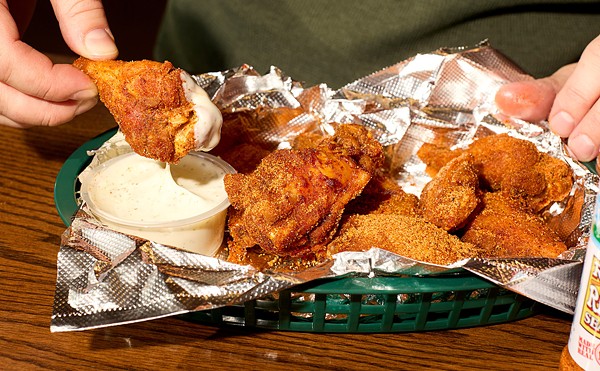Other than my dining companions, my experiences at India Kitchen were remarkably similar during each trip: The service was affable but unpolished, the entrées were excellent, the appetizers were acceptable and the side dishes were lousy.
Just as there is no single American cuisine, there is no single Indian cuisine; the culinary vastness of India has been transformed into a commonly understood archetype, one that seldom varies in America from restaurant to restaurant. In America, a hamburger is a hamburger and rogan josh is rogan josh. India Kitchen's cuisine fits this mold.
The restaurant itself is well kept, with half-a-dozen booths and just as many tables. The dining room is sparsely but tastefully decorated. During both our visits, we were the only customers, which was probably good, because it took several minutes and a lot of pointing to get our order in. The language barrier not withstanding, the service was friendly and eager: One of the waiters actually cut a straw in half for my nephew.
As noted earlier, the restaurant's entrées, both vegetarian and meat-based, were excellent. The fish tikka masala was incredible, perhaps the best version of that dish that I've ever had. The savory sauce had sweet overtones, and exuded a cinnamon scent and a light hint of caramel. The fish was fleshy and held up well on the fork, but ultimately that didn't much matter -- after one taste, I would have eaten the sauce as a soup. Although not one of the most adventurous dishes you can order, the always-popular chicken curry's aromatic tomato-based sauce was just spicy enough to announce its presence. The tandoori chicken, not usually my favorite dish, came to the table with the expected red sheen. The meat was succulent and moist, and the seasoning had permeated the flesh. The accompanying vegetables were smoky and popular with my guests (though, admittedly, I have trouble getting excited about grilled vegetables). The lamb rogan josh, one of my favorite Indian dishes, was a little strong on the cinnamon. Its savory sauce had a definite sweetness and balanced well with the assertive flavor of lamb. The chicken shai korma was soft and buttery, with a lingering kick that built up over time.
The iddly -- white flying-saucer patties of steamed rice and lentils -- had a mild, almost fishy taste. I was a bit turned off by the texture: It was a little like crustless Wonder Bread squished into a tight ball. As a result, these were unexciting, except as a vessel for the pungent, spicy dipping sauce (which, too, would make a good winter soup). The paper masala dosai, on the other hand, were impressive. Curried onions and potatoes were served in a two-foot-long crispy, golden rolled crêpe. Even better was the paneer pakora, a crisp pocket of chickpea flour fried around a nugget of traditional Indian cottage cheese (paneer). Fried cheese, in any culture, is hard to beat.
I was, however, disappointed with was the chicken vindaloo. It tasted fine, but it wasn't prepared with the tomato-based sauce that's common in other Indian restaurants. India Kitchen's version was served in heavily spiced gravy, with a zippy tomato tang that reminded me more of ketchup than of the tomato base I was looking for. Variation, of course, is encouraged, but it has to succeed.
The vegetable curries I tasted all hit the mark. Dal tadaka -- neon-yellow lentils -- were pleasantly earthy, and the spice hit moments after you put down your fork. The palak paneer (curry spinach with cottage cheese) had little pockets of cinnamon hidden within. The channa masala, slow-cooked chickpeas, were spicier than the other vegetable dishes (in terms of heat level, think medium salsa).
Unfortunately, the side dishes that accompanied the meals were uniformly disappointing. All of the breads were poor. The naan lacked its traditional puffiness -- it arrived flat and charred on one side. Plus, the bread had obviously been sitting for much of the day and seemed to have been carelessly reheated for my dinner. The poori, paratha and chapatti, all wheat breads, were greasy and distasteful. The poori had a sheen of grease, but that makes sense because it's fried. But the other two breads should have had a cleaner feel.
The rice also had problems, which is unacceptable. Rice is an Indian staple, yet the basmati rice served with each entrée was overcooked -- dense, wet and lacking the usual pungent, perfumed flavor. It was clearly inferior to what I could whip up at home.
Probably what's most striking about India Kitchen is how unstriking it is, a problem with Indian restaurants in general. Like the Spice Girls and soccer hooligans, some of the uniformity in Indian restaurants can be blamed on the British. There was no single curry in Indian cooking until the British, with the help of the East India Company, institutionalized curry powder. Although most restaurants use slightly different proportions of the spices, the dishes don't vary very much from restaurant to restaurant. Even within one restaurant, some dishes aren't much different from others. It is a common practice for Indian restaurants to cook different items in the same sauces, using chili powder to vary the heat.
The quality of the entrées and appetizers outweighs the mediocrity of the rice and breads. India Kitchen doesn't exactly set the bar for Indian restaurants everywhere, but it's not a bad place to have in your neighborhood.





